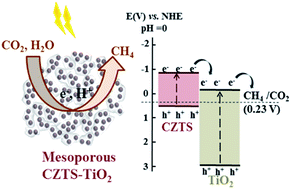Hybrid mesoporous Cu2ZnSnS4 (CZTS)–TiO2 photocatalyst for efficient photocatalytic conversion of CO2 into CH4 under solar irradiation†
Abstract
A major concern facing global society is the ongoing excessive release of CO2 into the atmosphere where it acts as a heat-trapping greenhouse gas. One approach to helping control atmospheric CO2 concentrations is to use solar energy to convert CO2 into useful products, namely hydrocarbons, by use of specifically designed photocatalytic materials. While numerous photocatalysts have been investigated for use in CO2 reduction, the field remains in it's infancy with, overall, relatively poor photoconversion efficiencies and product selectivity. This study reports the synthesis and design of a mesoporous noble metal free p-type Cu2ZnSnS4 (CZTS)/n-type TiO2 heterojunction photocatalyst for broad spectrum light absorption, enhanced charge separation and transfer that, in turn, enhances photocatalytic CO2 conversion. A maximum methane production rate of 118.75 ppm g−1 h−1 is observed, which represents a methane evolution rate approximately 12 times greater than that of pure TiO2. The key factors contributing to the enhanced photocatalytic performance seen in the mesoporous CZTS–TiO2 samples include improved light absorption, high surface area, and effective charge separation.


 Please wait while we load your content...
Please wait while we load your content...